The River Waveney: The ‘secret’ UK waterway most Brits don’t know

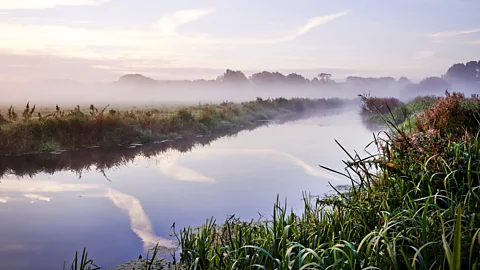 Alamy
AlamySteeped in history, it played a central role in Roger Deakin’s groundbreaking book Waterlog that kick-started Britain’s wild swimming movement.
“The Waveney for me, as my local river, has always been a kind of escape route,” the late naturalist and wild swimming enthusiast Roger Deakin once said in a BBC radio piece. “It’s a way into another world.”
The Waveney is my local river, too. And as this year marks 25 years since Deakin’s ground-breaking book Waterlog: A Swimmer’s Journey Through Britain, which arguably launched Britain’s wild swimming movement by embracing the outdoors, encouraging the “right to swim” and arguing that “natural water has always held the magical power to cure”, I wanted to journey the length of this waterway most Brits haven’t heard of with a dip, kayak and pedal about to unearth its allure.
Deakin lived for 26 years in a 16th-Century farmhouse in the village of Mellis, four miles south of the Waveney, where he would swim in its moat. His regular wild dip sparked the idea of 36 swim adventures in places across Britain. Breaststroke inspired pen stroke and his cult classic emerged. In his three dozen plunges for Waterlog, he took in the Isles of Scilly with a snorkel and submersions in ice-cold tarns in Wales. But the Waveney was his favourite river and he would return to it time and again, devoting much of the chapter Extinctions to the waterway.
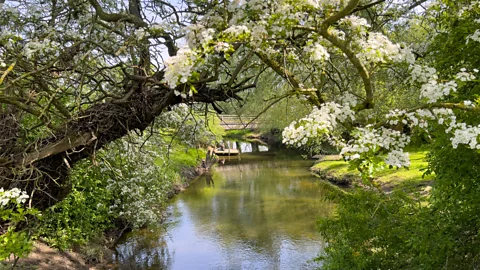 Claire Boobbyer
Claire BoobbyerThe Waveney was a “secret river” he wrote, “by turns lazy and agile, dashing over shallow beds of golden gravel, then suddenly quiet, dignified and deep… With its secret pools and occasional sandy beaches, the Waveney is full of swimming holes, diving stages improvised from wooden pallets, dangling ropes and upturned canoes pulled up on the bank.”
Slowcomotion is a BBC Travel series that celebrates slow, self-propelled travel and invites readers to get outside and reconnect with the world in a safe and sustainable way.
Deakin often biked to many of his wild swimming destinations. “The quality of cycling is akin to swimming,” he described in Waterlog. “I enjoy the gliding, swooping motion of the bike as I enjoy the grace of swimming.”
Deakin canoed the Waveney, too. He produced a radio documentary for the BBC on paddling the river from its source at Redgrave and Lopham Fen via Hoxne to the Geldeston Locks in a vessel named Cigarette.
The Waveney meanders along 59 miles of the Norfolk-Suffolk border in East Anglia before slipping into the River Yare and nosediving to the sea at Great Yarmouth. Along its willow tree-shaded watery kinks are an award-winning vineyard, an award-winning cheese dairy, craft breweries and indie cafes. Otters, kingfishers, endangered lapwings and water voles call the river home.
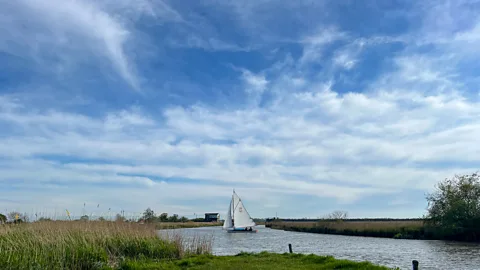 Claire Boobbyer
Claire BoobbyerDrainage mills, which once emptied the marshes of water for crops and cattle, remain upright, like sentinels. In winter, an elusive mantle hovers over the gloam with ghost-white mills looming large; reeds stiffen with frost. In spring, pussy willow seed fluff settles on the river like the softest of snow. And in summer, birds chatter and hedges swell with wild blooms.
The Waveney marks the southern extent of the Broads National Park, but it’s all quite under-the-radar and deliciously underdeveloped, with barely a road alongside. My partner and I cycled as close to the river as possible to trace its route and uncover its secrets. From Diss, a Norfolk market town (handy with its railway station), we cycled 104 miles across four days over gently undulating river valley to the sea, staying at B&Bs along the way.
Five miles west of Diss, Hoxne is a quaint village home to extraordinary stories. Edmund the Martyr, the 9th-Century king of East Anglia, and England’s original patron saint, hid from enemy soldiers under Goldbrook Bridge. His golden spurs, reflected in the water, betrayed his position and he was given up by a passing wedding party. At the St Edmund’s Cross memorial nearby, which commemorates the site of his capture and beheading at an oak tree, a gardener told us: “Wedding folk don’t use that bridge even now. They go around.”
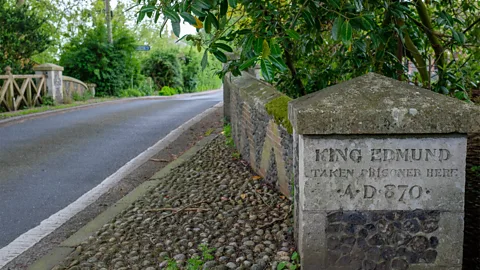 Claire Boobbyer
Claire BoobbyerEdmund’s story is somewhat eclipsed by that of the Hoxne discovery of 15,000 coins, the largest hoard of Roman gold and silver ever found in the UK.
After a swift pint mulling treasure at the timbered Swan Inn, we pedalled down a lane fragrant with wild garlic to what is arguably the most beautiful mill house on the Waveney. Deakin thought so, too, as he mentions it as a highlight in his radio piece.
Slow travel along the Waveney
Suffolk Bike Hire offers one-way rentals for cyclists. Ramblers can walk the Angles Way (which is sometimes aligned to the river and sometimes gives it a wide berth) from Knettishall Heath to Great Yarmouth. Walkers and bikers may also want to use Hike Help, which transports luggage between B&Bs.
Just south of the town of Harleston sits Shotford Bridge. Beneath, there’s a popular swimming spot that’s looked after by The River Waveney Trust. “The [wild swimming] movement highlights that people do want to swim in rivers and the water quality should be good enough for everybody to swim,” said trust director Martha Meek.
After a swim in the cool river shaded by willow branches drooping into the water and glancing red dragonflies and damselflies in sapphire blue darting about, we refreshed at The Cap, a craft brew pub in Harleston, for a pint of Ampersand’s Bidon pale ale and a summery Basil Blush with raspberry.
We then cycled to the village of Mendham, crossing the bridge spanning the river and water meadows in the early evening sun as cows munched the grass. We stayed at the pocket-friendly Sir Alfred Munnings Hotel. The pretty mill at Mendham (now a holiday let) straddling the river is the birthplace of Sir Alfred Munnings (1878-1959), known as England’s finest painter of horses – some of whose early scenes depict life in the Waveney Valley.
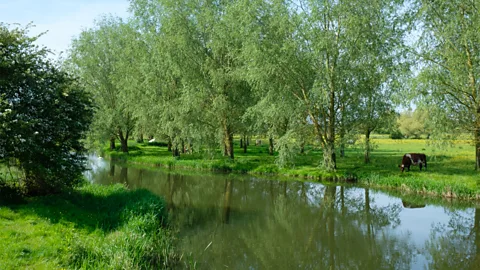 Claire Boobbyer
Claire BoobbyerWe glimpsed more valley life the following morning: Wortwell village’s large striking-white weatherboard watermill is first mentioned in the Domesday Book, William the Conqueror’s land survey of England. And at Homersfield village, we soaked up the sun-dappled river scene from a small bridge. Built in 1869, it’s the oldest concrete bridge in Britain and arcs a sluggish spot in the river. We swam here, too, in the water, drinking in the wildness and romance. Water voles plopped into the river, their loud splashes breaking the peace. Deakin himself had spotted water vole holes “the size of tennis balls in the banks” as he paddled in Cigarette.
The Waveney at Bungay balloons in an oxbow curl. (Hire a canoe at Outney Meadow Caravan Park to paddle the waters here, and perhaps see an otter.) In Waterlog, Deakin swims around a bend in the Waveney and encounters an otter “sunning itself on a floating log near the reed-bed”. Bungay is an enigmatic place with indie shops and cafes (great lunches at Earsham Street) and a 12th-Century castle. Known for its association with a demonic Black Shuck hound (honoured with an annual festival), lace curtains twitched in 2023 when it was called the Satanist capital of Britain.
Escaping any potential clutches of the legendary dog, we cycled north to Flint Vineyard. A glass of mineral-y, elderflower-y Bacchus Fumé primed us before we climbed Annis Hill for a glimpse of private Mettingham Castle. We revived on the smell and taste of Ethiopian coffee at Silo Café where beans roast in a soaring 1950s grain silo on the river at Wainford.
The caffeine powered us on to one of the Waveney’s most enchanting scenes: the white weather-boarded Ellingham Mill that overlooks a river pool with drifting swans. From here, the rural Geldeston Road lured us east to another of the river’s highlights – the Locks Inn – right on the water and known for its live music. Deakin ordered a pint here as he docked Cigarette at the locks.
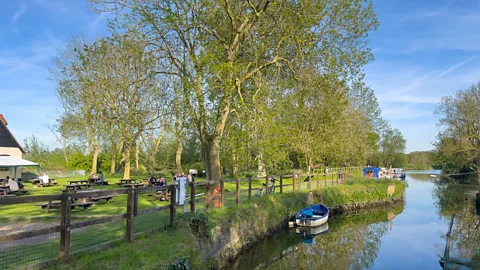 Claire Boobbyer
Claire BoobbyerGeldeston’s bigger neighbour, Beccles, sits high on a cliff above the Waveney, with its huge church commanding the town. At Northgate street, the curved lane is riven with alleys that slope down to the river. In bygone centuries, wherries (sail boats designed to navigate shallow water) plied up and down the river’s navigable arm to Beccles transporting goods such as malt, corn and coal.
After a night in the beamed 16th-Century Swan House, we organised a guided kayak tour to see more of the river via Hippersons Boat Yard. As our paddles chopped the silky water, our guide recounted stories of reed cutting; herring history; Norfolk and Suffolk rivalry; and the eel, carp and perch swimming beneath us.
The Waveney disappears into the marshes after Beccles. We didn’t glimpse it again until beautiful Carlton Marshes Nature Reserve, 7.5 miles away. We explored the bird hides huddled in the reeds and looked out for booming bitterns, Chinese water deer and rare hovering marsh harriers.
The marshlands snuggle up to Oulton Broad, a spur of the Waveney via Oulton Dyke. We biked north to picturesque Somerleyton Hall & Gardens. Beyond, in Somerleyton village, a cylindrical monument honours the Hovercraft (invented in 1955) and its creator, Sir Christopher Cockerell. We parked our bikes at Somerleyton Cycles (which stores panniers) while we walked the dreamy, sun-drenched route by the water to the timber-framed, octagonal Herringfleet smock drainage mill, the last of its kind on the Broads.
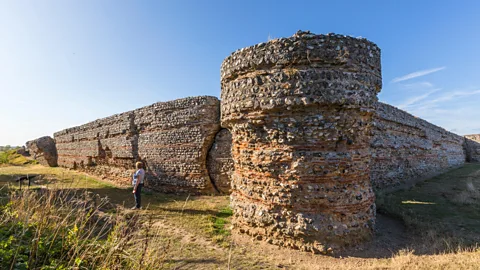 Alamy
AlamyIt wasn’t until we reached the Fisherman’s Inn that we appreciated the past toil of the region’s mills. From the pub garden, endless marsh and distant mills steamed in the glare of the sun. The river coiled about the flatlands shimmering like quicksilver.
Close to the inn are the thick, gnarly stone walls of vast Burgh Castle raised on a cliff at the confluence of the Waveney and the Yare. It’s one of the best-preserved Roman monuments in Britain and while the west wall has collapsed into the marshes giving the high-perched ruins a million-dollar view, what’s so sobering is that although mud, tides and time have shaped this shifting coastal area, the area is little developed since 3rd-Century Roman soldiers defended the estuary.
Our journey had indeed offered us an escape into an unhurried, wild and different world. Deakin would still recognise his river, I thought.
Related
Calls for over 60 free bus travel update from Department…
Calls for free bus travel for those over the age of 60 in England is gaining more attention after an increase of support. Unlike those in Wales, Scotland, and N
Major UK train station is one of the worst places…
Pickpockets are a problem across the UK, but one place is the worst for having your belongings stolen. According to the British Transport Police (BTP), just und
UK Snow Travel Chaos: Kent, East Sussex, West Sussex, Hampshire,…
UK Snow Travel Chaos: Kent, East Sussex, West Sussex, Hampshire, Wiltshire, Surrey, Berkshire, Greater London, Essex, Suffolk, Hertfordshire,
‘Only travel if necessary’ warning as UK’s busiest motorway shut…
NATIONAL Highways have issued an urgent warning to drivers as one the UK's biggest motorways shuts for the weekend. They has urged drivers to re-plan their rou












